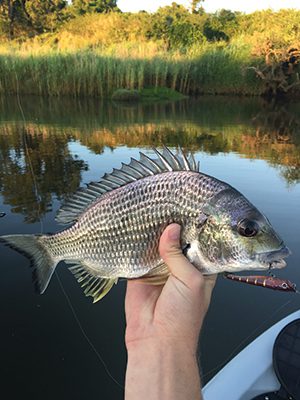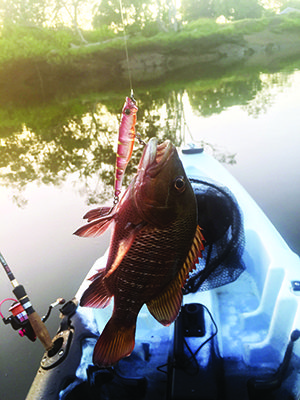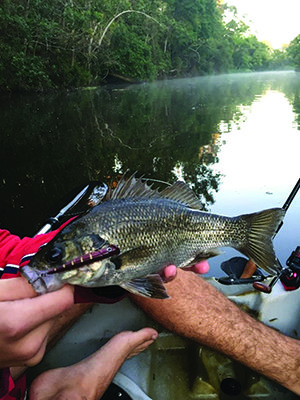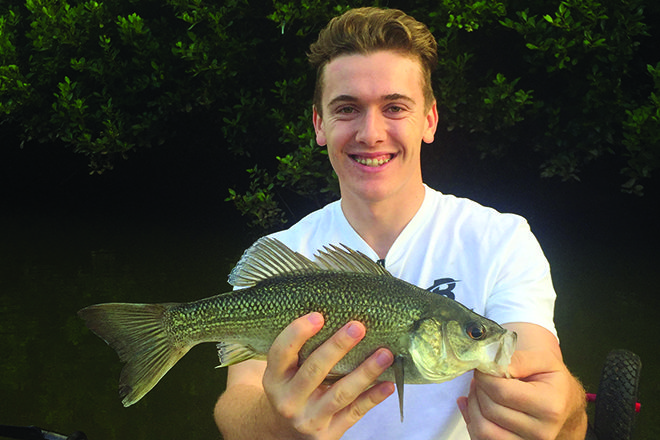MY name is Mitch Townsend and I am based on Brisbane’s northside.
I’ve been fishing since I was a young boy and have most recently been fishing the upper reaches of the North and South Pine rivers, targeting bream and bass on surface with great success. I grew up fishing the North Pine River from Dad’s old tinnie, and I remember one day about three weeks after a big flood we were throwing prawn-imitation soft plastics towards a mangrove-lined bank when Dad hooked a huge 52cm bass.
I’d never seen or heard of bass being caught in rivers, so this prompted me to explore where these wild bass might be living. After doing a little research I found the majority of bass that live in the Pine River were washed over the North Pine Dam wall in the floods. With this in mind, I decided to fish the stretch of the river between the dam wall and Youngs Crossing. I fished this spot about 10 times over a year for roughly one or two fish each time. While fish are there, the ones I caught were extremely skinny and quite lethargic.
I really wanted to look for a more productive location where I could get more than two bass a session. I fished Lake Kurwongbah, catching a number of bass by working the weed edges, and I was even lucky enough to land a saratoga off the surface. While I was having great success in Kurwongbah, I really wanted to land more of the elusive wild bass, so I did some more research and went exploring. The creeks near Dayboro were my first port of call, however I had no success and started to think I would just have to be satisfied with catching impoundment bass.
Then one afternoon I was kayak fishing the North Pine upriver from One Mile Country Club with a small green, orange and yellow Zerek Tango Shad. I was casting to the edges when my lure was slammed. The fish fought extremely well, taking me back into the snag and running all around the kayak, keeping me guessing as to its identity. It turned out to be a solid bream, and in that afternoon I landed five. I approached another good-looking stretch of river with high hopes of more bream.
Instead I landed a wild bass. At 35cm it was no monster but I knew more would be in there, so that’s where I’ve been fishing ever since. I have now started to understand when, why and what the bass prefer to feed on, which is why I believe I’ve had more success.
Prawns have recently been running in the Pine River and juveniles are making their way to the upper reaches. Before sunrise you can see them skipping around on the surface, so I’ve attempted to match them with my surface lure. I use a Berkley 3B Pop Dog in Mutt colour, which effectively imitates a small prawn. I have found I get the best results by casting right in tight to structure such as snags, rocks, mangroves and overhanging trees and working the lure slowly.
My retrieve is consistent and I give the lure small pops so a small amount of water is displaced. Too much water and the fish become somewhat nervous. Between the pops I pause for two or three seconds, which is usually when the fish will hit. It is important to be able to cast accurately and consistently if you want good results. The rod I use for working surface lures is a Brisbane River Boys Lightning ML 2000 with a matching Brisbane River Boys reel.
I find the rod has a stiff tip that is perfect for working the surface lure. The reel is spooled with 8lb Shimano Power Pro braid and 6lb leader. I don’t believe the type of leader matters but then again I have never done much experimentation. If the bite slows I will change to a hard-body lure. Some of my favourites include Ecogear SX40s, Zerek Tango Shads, Premium Cranks from Softplasticsdude and small wooden Black Dog Lures.



I like a lure that dives quickly, and something that dives to about 2m is ideal. You want to have a mixture of floating and suspending lures in your tackle box. Which lure you use will depend on the structure you are fishing around. When targeting bass, I use lures between 40mm and 70mm in length, however they will take bigger lures. I prefer green-bodied lures with either a white or red belly. For some reason the green lures really encourage the bass to bite. I also find green, yellow and orange to be a good mixture, as is purple and the more natural colours.
My preferred soft plastic lure is a paddle tail of about 2.5” in white or a 2.5” curly tail grub in purple or brown. I don’t use Z-Man, Gulp or Squidgies plastics but instead cheaper brands such as Atomic and even no-name brands. I simply find the cheaper alternatives work just as effectively. Interestingly, I’ve had a lot more success when rigging the plastics with a TT Jig Spinner in the biggest size. While I’ve always used a gold spinner, I believe silver would work just as well.
You need to be out on the water at first light and fishing with surface lures until about 8.30am, however this time frame depends on the day. Overcast conditions can prolong the surface bite and a hot, sunny day can shorten it. The wind and water clarity also play a big role. If a breeze is causing a disturbance on the water it can encourage the fish to bite but if the water is very clear the fish will likely only feed in low-light conditions and once the sun is up will retreat to structure or deeper water. On the contrary, murky water will encourage a surface bite and allow you to upgrade your leader if some big fish are around.
It is also important to have a quality kayak that enables you to get to spots a boat couldn’t. The 2.8m Dragon Kayak Pro Fisher is ideal for this purpose because it is light and has exceptional tracking and comfort. Having a good kayak that keeps you balanced allows you to be extremely stealthy in those quiet creeks. Good tracking also means you are able to continue gliding straight ahead once you stop paddling rather than going left or right, which is so important when fishing small creeks.
I have used these basic principles and techniques to successfully catch bass and bream in the upper reaches of the Noosa River, Caboolture River, Pine River and other small creeks. Don’t be afraid to have a look around on Google Earth or Maps to find how you can access feeder creeks and the upper reaches of rivers because they will more than likely hold bass. I still have a lot of unknowns to figure out, such as how barometric pressure affects the fish and whether or not different tides impact their feeding patterns, but at the moment I am lucky enough to be consistently catching quality bream and bass in the upper reaches of the North and South Pine rivers.
If you have any questions about where I get my gear or anything else in this article, please just message my ‘Pine Boys’ Facebook page. I hope this information will help you target bream and bass on surface because there is no better feeling than watching your lure get smashed off the top.
 Bush ‘n Beach Fishing Magazine Location reports & tips for fishing, boating, camping, kayaking, 4WDing in Queensland and Northern NSW
Bush ‘n Beach Fishing Magazine Location reports & tips for fishing, boating, camping, kayaking, 4WDing in Queensland and Northern NSW









